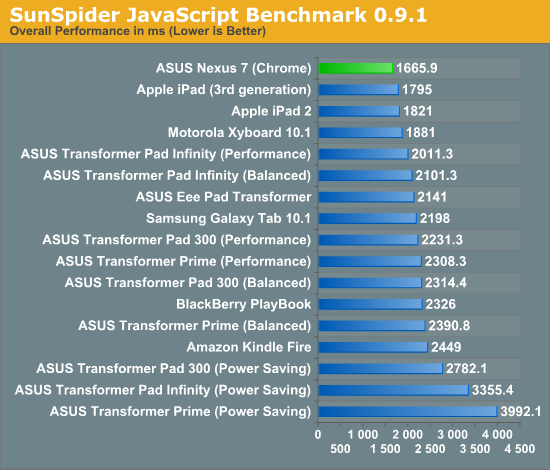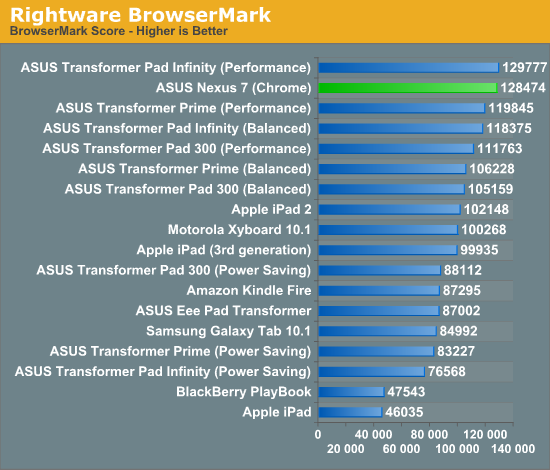The Google Nexus 7 Review
by Anand Lal Shimpi & Brian Klug on July 26, 2012 11:35 AM ESTThe SoC & Performance
While Amazon chose TI's OMAP 4 for the Kindle Fire, Google and ASUS picked arguably the second best SoC on the market today: NVIDIA's Tegra 3. Keep in mind that high-end ARM SoCs generally sell in the $14 - $25 range per chip, which a fabless semiconductor manufacturer has to split with a foundry. The result is a far cry from the margins NVIDIA is used to making on high-end discrete GPUs. I suspect a desire to make good use of all functional Tegra 3 parts that come back from the fab is the reason why we have so many variants of the Tegra 3.
To date we've seen three Tegra 3 SKUs used in tablets: T30L, T30 and T33. Factor in the smartphone SKUs (AP30, AP33) and it's already a pretty healthy collection for a single chip. The main differences between the 30L, 30 and 33 parts are voltages and clock speeds. I've shown this table in previous articles but I present it here again since T30L is what's in the Nexus 7:
| NVIDIA Tegra 3 | |||||||
| CPU Cores | Max CPU Clock (1 core active) | Max CPU Clock (multiple cores) | GPU Cores | Max GPU Clock | |||
| NVIDIA Tegra 3 (T33) | 4+1 | 1.7GHz | 1.6GHz | 12 | 520MHz | ||
| NVIDIA Tegra 3 (T30) | 4+1 | 1.4GHz | 1.3GHz | 12 | 520MHz | ||
| NVIDIA Tegra 3 (T30L) | 4+1 | 1.3GHz | 1.2GHz | 12 | 416MHz | ||
The loss in performance compared to T30/T33 is marginal at best, at least for most consumer use cases. Four Cortex A9s running at up to 1.3GHz is definitely quick enough for the types of applications you'll run on the Nexus 7. Things can always be faster, but like the Kindle Fire's OMAP 4, the Nexus 7's T30L is good enough for now. Give it another year and we'll see something even faster at this price point. That's the downside of buying anything in the tablet/smartphone space these days unfortunately.
| ASUS Android Tablet Memory Choices | ||||||
| TF Prime | TF Pad 300 | Nexus 7 | TF Pad Infinity | |||
| Memory Capacity | 1GB | 1GB | 1GB | 1GB | ||
| Memory Type | DDR2-1000 | DDR3L-1333 | DDR3L-1333 | DDR3-1600 | ||
| Memory Bandwidth | 4.0GB/s | 5.3GB/s | 5.3GB/s | 6.4GB/s | ||
ASUS selected 1GB of DDR3L-1333 memory for the Nexus 7. This gives it more memory bandwidth than any of the Transformer series of tablets, with the exception of the Transformer Pad Infinity. Since the Tegra 3 SoC only has a single channel memory interface, ASUS had to rely on higher frequency memory to deliver sufficient bandwidth.
Note that the browser performance tests below paint a very good picture for the Nexus 7's performance because Android 4.1 replaces the default web browser with Chrome, with a much faster javascript engine.













118 Comments
View All Comments
trajik78 - Thursday, July 26, 2012 - link
my buddy at work just got his Nex7. it's great, but the speaker is REALLY REALLY bad. distorts even at low volume.rfdparker - Friday, July 27, 2012 - link
I had the same issue. I tried a stereo audio test video from YouTube, and it seemed one of the pair of speakers had already blown on/before arrival, whilst the other was fine.So I'm getting it swapped today.
ImSpartacus - Saturday, July 28, 2012 - link
If Google had to skimp somewhere, I'm glad they skimped on the speakers.klmccaughey - Wednesday, August 8, 2012 - link
You still need *useable* speakers. If they are so bad you can't hear a thing then that rather detracts from the whole experience.lordsaytor - Friday, September 14, 2012 - link
Well said. It really is a shame. The Nexus 7 is such a fantastic tablet to use. If not for these minor flaws (the speaker, lack of hdmi, lack of expandable memory) this would be a perfect product. It would have taken the gold editor's award easily.But having said that, I can't complain about the $199 price tag and I suppose you get what you pay for.
But being the first ever tablet Google has made, I think things in the 7 inch market looks very promising. Other manufacturers (Apple, Amazon, Samsung) will have no choice but to make an even better tablet for the same price in order to take market share in the 7 inch category.
Johnmcl7 - Thursday, July 26, 2012 - link
I'm disappointed that micro SD slots seem to be disappearing from high profile Android devices and frustrating reviewers seem to skip over it. I can see why manufacturers want to take micro SD slots off devices but losing the slot is no benefit to consumers and being able to add lots of cheap memory to a device with an HD screen prime for video and games is useful.John
Wiggy McShades - Thursday, July 26, 2012 - link
I'd imagine google wants to try and sell people cloud storage rather than let them go and buy a micro sd card.mcnabney - Thursday, July 26, 2012 - link
Which makes no sense on a WiFi-only device.NoNeedForMonkeys - Saturday, August 4, 2012 - link
My N7 is wifi tethered to my phone when I am mobile.kmmatney - Thursday, July 26, 2012 - link
Seeing how quickly my son's 8GB iPod touch filled up, I think they could have really used more memory. Web browsing and streaming is OK, but you won't be able to install very many games, or put a full music library on it. It can't be that much more expensive to add another 16 GB.